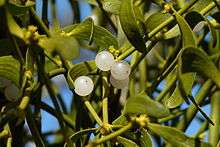Viscum
Viscum is a genus of about 70–100 species of mistletoes, native to temperate and tropical regions of Europe, Africa, Asia and Australasia. [1] Traditionally, the genus has been placed in its own family Viscaceae, but recent genetic research by the Angiosperm Phylogeny Group shows this family to be correctly placed within a larger circumscription of the sandalwood family, Santalaceae.
| Viscum | |
|---|---|
 | |
| Viscum album growing on a Populus species | |
| Scientific classification | |
| Kingdom: | Plantae |
| Clade: | Tracheophytes |
| Clade: | Angiosperms |
| Clade: | Eudicots |
| Order: | Santalales |
| Family: | Santalaceae |
| Genus: | Viscum L. |
| Species | |
|
See text | |
They are woody, obligate hemiparasitic shrubs with branches 15–80 centimetres (5.9–31.5 in) long. Their hosts are woody shrubs and trees. The foliage is dichotomously or verticillately branching, with opposite pairs or whorls of green leaves which perform some photosynthesis (minimal in some species, notably V. nudum), but with the plant drawing its mineral and water needs from the host tree. Different species of Viscum tend to use different host species; most species are able to use several different host species.
The flowers are inconspicuous, greenish-yellow, 1–3 millimetres (0.039–0.118 in) diameter. The fruit is a berry, white, yellow, orange, or red when mature, containing one or more seeds embedded in very sticky juice; the seeds are dispersed when birds (notably the mistle thrush) eat the fruit, and remove the sticky seeds from the bill by wiping them on tree branches where they can germinate.
Toxicity in the genus Viscum
Viscum species are poisonous to humans; eating the fruit causes a weak pulse and acute gastrointestinal problems including stomach pain and diarrhea.[2] At least one of the active ingredients is the lectin viscumin, which is intensely toxic. It inhibits protein synthesis by catalytically inactivating ribosomes.[3] In spite of this, many species of animals are adapted to eating the fruit as a significant part of their diet.[4]
Fossil record
†Viscum morlotii from the early Miocene, has been described from fossil leaf compressions that have been found in the Kristina Mine at Hrádek nad Nisou in North Bohemia, the Czech Republic.[5]
Selected species


- Viscum album – European mistletoe
- Viscum articulatum
- Viscum bancroftii
- Viscum capense – Cape mistletoe (South Africa)
- Viscum coloratum – Korean mistletoe[6] (Korea)
- Viscum combreticola Engl. – combretum mistletoe
- Viscum cruciatum – red-berried mistletoe
- Viscum diospyrosicola
- Viscum fargesii
- Viscum liquidambaricola
- Viscum loranthi
- Viscum minimum
- Viscum monoicum
- Viscum multinerve
- Viscum nudum
- Viscum orientale
- Viscum ovalifolium
- Viscum rotundifolium L.f. – round-leaved or red-berry mistletoe
- Viscum triflorum
- Viscum whitei
- Viscum yunnanense
References
- O'Neill, A. R.; Rana, S. K. (2019). "An ethnobotanical analysis of parasitic plants (Parijibi) in the Nepal Himalaya". Journal of Ethnobiology and Ethnomedicine. 12 (14). doi:10.1186/s13002-016-0086-y.
- Carnegie Library, Science and Reference division (1997). The Handy Science Answer Book. Visible Ink Press. ISBN 9780787610135.
- Sjur Olsnes, Fiorenzo Stirpe, Kirsten Sandvig, Alexander Pihl. Isolation and Characterization of Viscumin, a Toxic Lectin from Viscum album L. THE JOURNAL OF BIOLOGICAL CHEMISTRY Vol. 257, No 22, November 25, pp. 13263-13270, 1982.
- David M. Watson, "Mistletoe-A Keystone Resource in Forests and Woodlands Worldwide" Annual Review of Ecology and Systematics 32 (2001:219–249).
- A review of the early Miocene Mastixioid flora of the Kristina Mine at Hrádek nad Nisou in North Bohemia, The Czech Republic, January 2012 by F. Holý, Z. Kvaček and Vasilis Teodoridis - ACTA MUSEI NATIONALIS PRAGAE Series B – Historia Naturalis • vol. 68 • 2012 • no. 3–4 • pp. 53–118
- English Names for Korean Native Plants (PDF). Pocheon: Korea National Arboretum. 2015. p. 679. ISBN 978-89-97450-98-5. Archived from the original (PDF) on 25 May 2017. Retrieved 8 December 2016 – via Korea Forest Service.
- Flora of China: Viscum
- Flora of Pakistan: Viscum
- Flora Europaea: Viscum
- "Viscum L." Australian Plant Name Index (APNI), IBIS database. Centre for Plant Biodiversity Research, Australian Government.
- Mistletoe Pages: Viscum